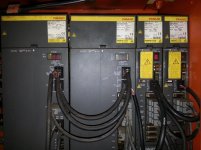nadeemcutterwala
Plastic
- Joined
- Apr 3, 2014
- Location
- Mumbai, India
Hello all.
Just ran into a problem. I am having Servo alarm no. 414 flashing on the screen. It says 'X-axis detect error'. Help needed to fix the issue. I have FANUC O-MC Control. The machine has been manufactured in 1998. Serial nos for servo amplifier module are as follows:
1. Servo amplifier module:
A06B-6079-H206
A06B-6079-H104
2. Spindle amplifier module: A06B-6088-H215#H500
3. Power supply module: A06B-6087-H115
4. Machine manufacturer: Victor Taichung Machines
5. Model name: VCENTER-80
6. Series No.: NT-2207
Please guys. Any suggestions?
Just ran into a problem. I am having Servo alarm no. 414 flashing on the screen. It says 'X-axis detect error'. Help needed to fix the issue. I have FANUC O-MC Control. The machine has been manufactured in 1998. Serial nos for servo amplifier module are as follows:
1. Servo amplifier module:
A06B-6079-H206
A06B-6079-H104
2. Spindle amplifier module: A06B-6088-H215#H500
3. Power supply module: A06B-6087-H115
4. Machine manufacturer: Victor Taichung Machines
5. Model name: VCENTER-80
6. Series No.: NT-2207
Please guys. Any suggestions?
Last edited:




